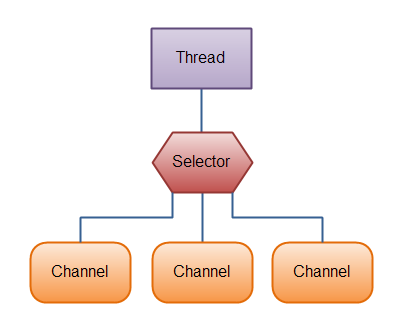Java基础知识强化之IO流笔记72:NIO之 NIO核心组件(NIO使用代码示例)
2016-03-29 10:58
1101 查看
1.Java NIO 由以下几个核心部分组成:
Channels(通道)
Buffers(缓冲区)
Selectors(选择器)
虽然Java NIO 中除此之外还有很多类和组件,Channel,Buffer 和 Selector 构成了核心的API。其它组件,如Pipe和FileLock,只不过是与三个核心组件共同使用的工具类。
(1)Channel 和 Buffer
基本上,所有的 IO操作在NIO 中都从一个Channel 开始。Channel 有点像 流。 数据可以从Channel读到Buffer中,也可以从Buffer 写到Channel中。这里有个图示:

Channel和Buffer有好几种类型。
下面是JAVA NIO中的一些主要Channel的实现:
FileChannel
DatagramChannel
SocketChannel
ServerSocketChannel
正如你所看到的,这些通道涵盖了UDP 和 TCP 网络IO,以及文件IO。
与这些类一起的有一些有趣的接口,但为简单起见,我尽量在概述中不提到它们。本教程其它章节与它们相关的地方我会进行解释。
以下是Java NIO里主要的Buffer实现:
ByteBuffer
CharBuffer
DoubleBuffer
FloatBuffer
IntBuffer
LongBuffer
ShortBuffer
这些Buffer覆盖了你能通过IO发送的基本数据类型:byte, short, int, long, float, double 和 char。
Java NIO 还有个 MappedByteBuffer,用于表示内存映射文件, 我也不打算在概述中说明。
(2)Selector
Selector允许单线程处理多个 Channel。如果你的应用打开了多个连接(通道),但每个连接的流量都很低,使用Selector就会很方便。例如,在一个聊天服务器中。
这是在一个单线程中使用一个Selector处理3个Channel的图示:

要使用Selector,得向Selector注册Channel,然后调用它的select()方法。这个方法会一直阻塞到某个注册的通道有事件就绪。一旦这个方法返回,线程就可以处理这些事件,事件的例子有如新连接进来,数据接收等。
2. NIO使用代码示例:
java NIO服务端和客户端代码实现,为了更好地理解java NIO,下面贴出服务端和客户端的简单代码实现:
[b]服务端:[/b]
[b]客户端:[/b]
Channels(通道)
Buffers(缓冲区)
Selectors(选择器)
虽然Java NIO 中除此之外还有很多类和组件,Channel,Buffer 和 Selector 构成了核心的API。其它组件,如Pipe和FileLock,只不过是与三个核心组件共同使用的工具类。
(1)Channel 和 Buffer
基本上,所有的 IO操作在NIO 中都从一个Channel 开始。Channel 有点像 流。 数据可以从Channel读到Buffer中,也可以从Buffer 写到Channel中。这里有个图示:

Channel和Buffer有好几种类型。
下面是JAVA NIO中的一些主要Channel的实现:
FileChannel
DatagramChannel
SocketChannel
ServerSocketChannel
正如你所看到的,这些通道涵盖了UDP 和 TCP 网络IO,以及文件IO。
与这些类一起的有一些有趣的接口,但为简单起见,我尽量在概述中不提到它们。本教程其它章节与它们相关的地方我会进行解释。
以下是Java NIO里主要的Buffer实现:
ByteBuffer
CharBuffer
DoubleBuffer
FloatBuffer
IntBuffer
LongBuffer
ShortBuffer
这些Buffer覆盖了你能通过IO发送的基本数据类型:byte, short, int, long, float, double 和 char。
Java NIO 还有个 MappedByteBuffer,用于表示内存映射文件, 我也不打算在概述中说明。
(2)Selector
Selector允许单线程处理多个 Channel。如果你的应用打开了多个连接(通道),但每个连接的流量都很低,使用Selector就会很方便。例如,在一个聊天服务器中。
这是在一个单线程中使用一个Selector处理3个Channel的图示:

要使用Selector,得向Selector注册Channel,然后调用它的select()方法。这个方法会一直阻塞到某个注册的通道有事件就绪。一旦这个方法返回,线程就可以处理这些事件,事件的例子有如新连接进来,数据接收等。
2. NIO使用代码示例:
java NIO服务端和客户端代码实现,为了更好地理解java NIO,下面贴出服务端和客户端的简单代码实现:
[b]服务端:[/b]
package com.himi.demo2;
import java.io.IOException;
import java.net.InetSocketAddress;
import java.nio.ByteBuffer;
import java.nio.channels.SelectionKey;
import java.nio.channels.Selector;
import java.nio.channels.ServerSocketChannel;
import java.nio.channels.SocketChannel;
import java.util.Iterator;
/**
* NIO 服务端
*
* @author hebao
*/
public class NIOServer {
// 通道管理器
private Selector selector;
/**
* 获得一个ServerSocket通道,并对该通道做一些初始化的工作
*
* @param port
* 绑定的端口号
* @throws IOException
*/
public void initServer(int port) throws IOException {
// 获得一个ServerSocket通道
ServerSocketChannel serverChannel = ServerSocketChannel.open();
// 设置通道为非阻塞
serverChannel.configureBlocking(false);
// 将该通道对应的ServerSocket绑定到port端口
serverChannel.socket().bind(new InetSocketAddress(port));
// 获得一个通道管理器
this.selector = Selector.open();
// 将通道管理器和该通道绑定,并为该通道注册SelectionKey.OP_ACCEPT事件,注册该事件后,
// 当该事件到达时,selector.select()会返回,如果该事件没到达selector.select()会一直阻塞。
serverChannel.register(selector, SelectionKey.OP_ACCEPT);
}
/**
* 采用轮询的方式监听selector上是否有需要处理的事件,如果有,则进行处理
*
* @throws IOException
*/
@SuppressWarnings("unchecked")
public void listen() throws IOException {
System.out.println("服务端启动成功!");
// 轮询访问selector
while (true) {
// 当注册的事件到达时,方法返回;否则,该方法会一直阻塞
selector.select();
// 获得selector中选中的项的迭代器,选中的项为注册的事件
Iterator ite = this.selector.selectedKeys().iterator();
while (ite.hasNext()) {
SelectionKey key = (SelectionKey) ite.next();
// 删除已选的key,以防重复处理
ite.remove();
// 客户端请求连接事件
if (key.isAcceptable()) {
ServerSocketChannel server = (ServerSocketChannel) key.channel();
// 获得和客户端连接的通道
SocketChannel channel = server.accept();
// 设置成非阻塞
channel.configureBlocking(false);
// 在这里可以给客户端发送信息哦
channel.write(ByteBuffer.wrap(new String("向客户端发送了一条信息").getBytes()));
// 在和客户端连接成功之后,为了可以接收到客户端的信息,需要给通道设置读的权限。
channel.register(this.selector, SelectionKey.OP_READ);
// 获得了可读的事件
} else if (key.isReadable()) {
read(key);
}
}
}
}
/**
* 处理读取客户端发来的信息 的事件
*
* @param key
* @throws IOException
*/
public void read(SelectionKey key) throws IOException {
// 服务器可读取消息:得到事件发生的Socket通道
SocketChannel channel = (SocketChannel) key.channel();
// 创建读取的缓冲区
ByteBuffer buffer = ByteBuffer.allocate(10);
channel.read(buffer);
byte[] data = buffer.array();
String msg = new String(data).trim();
System.out.println("服务端收到信息:" + msg);
ByteBuffer outBuffer = ByteBuffer.wrap(msg.getBytes());
channel.write(outBuffer);// 将消息回送给客户端
}
/**
* 启动服务端测试
*
* @throws IOException
*/
public static void main(String[] args) throws IOException {
NIOServer server = new NIOServer();
server.initServer(8000);
server.listen();
}
}[b]客户端:[/b]
package com.himi.demo2;
import java.io.IOException;
import java.net.InetSocketAddress;
import java.nio.ByteBuffer;
import java.nio.channels.SelectionKey;
import java.nio.channels.Selector;
import java.nio.channels.SocketChannel;
import java.util.Iterator;
/**
* NIO客户端
*
* @author hebao
*/
public class NIOClient {
// 通道管理器
private Selector selector;
/**
* 获得一个Socket通道,并对该通道做一些初始化的工作
*
* @param ip
* 连接的服务器的ip
* @param port
* 连接的服务器的端口号
* @throws IOException
*/
public void initClient(String ip, int port) throws IOException {
// 获得一个Socket通道
SocketChannel channel = SocketChannel.open();
// 设置通道为非阻塞
channel.configureBlocking(false);
// 获得一个通道管理器
this.selector = Selector.open();
// 客户端连接服务器,其实方法执行并没有实现连接,需要在listen()方法中调
// 用channel.finishConnect();才能完成连接
channel.connect(new InetSocketAddress(ip, port));
// 将通道管理器和该通道绑定,并为该通道注册SelectionKey.OP_CONNECT事件。
channel.register(selector, SelectionKey.OP_CONNECT);
}
/**
* 采用轮询的方式监听selector上是否有需要处理的事件,如果有,则进行处理
*
* @throws IOException
*/
@SuppressWarnings("unchecked")
public void listen() throws IOException {
// 轮询访问selector
while (true) {
selector.select();
// 获得selector中选中的项的迭代器
Iterator ite = this.selector.selectedKeys().iterator();
while (ite.hasNext()) {
SelectionKey key = (SelectionKey) ite.next();
// 删除已选的key,以防重复处理
ite.remove();
// 连接事件发生
if (key.isConnectable()) {
SocketChannel channel = (SocketChannel) key.channel();
// 如果正在连接,则完成连接
if (channel.isConnectionPending()) {
channel.finishConnect();
}
// 设置成非阻塞
channel.configureBlocking(false);
// 在这里可以给服务端发送信息哦
channel.write(ByteBuffer.wrap(new String("向服务端发送了一条信息").getBytes()));
// 在和服务端连接成功之后,为了可以接收到服务端的信息,需要给通道设置读的权限。
channel.register(this.selector, SelectionKey.OP_READ);
// 获得了可读的事件
} else if (key.isReadable()) {
read(key);
}
}
}
}
/**
* 处理读取服务端发来的信息 的事件
*
* @param key
* @throws IOException
*/
public void read(SelectionKey key) throws IOException {
// 和服务端的read方法一样
}
/**
* 启动客户端测试
*
* @throws IOException
*/
public static void main(String[] args) throws IOException {
NIOClient client = new NIOClient();
client.initClient("localhost", 8000);
client.listen();
}
}
相关文章推荐
- Java Executors(线程池)
- java基本数据类型与二进制
- SiteMesh 3.0版本的简单使用
- Java四种线程池的使用
- java基础知识总结8(数据库篇1)
- java线程基础(一)
- SpringMVC表单标签简介
- Java重载和重写
- Java中高效判断数组中是否包含某个元素。
- SpringMVC测试
- java缓存框架详解
- Java中的内部类
- day12 JSP的指令:page,include静态包含;JavaBean;EL表达式
- java 求二叉树的深度
- 100天JAVA学习计划02-类和对象
- Java变量
- 我爱学Java之读取Properties的几种方法
- Java接口测试迭代器——pas-benchmark 测试圈:217937505 欢迎加入!!!
- Java中同一个类下一个方法怎样访问另一个方法下的变量
- java基础知识总结7(枚举+泛型)
